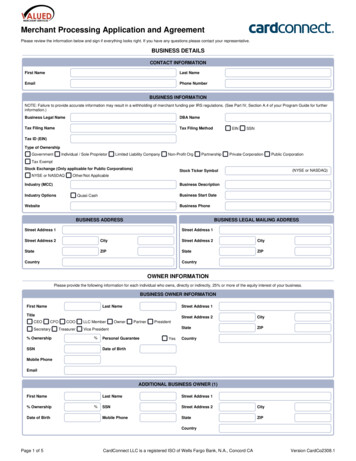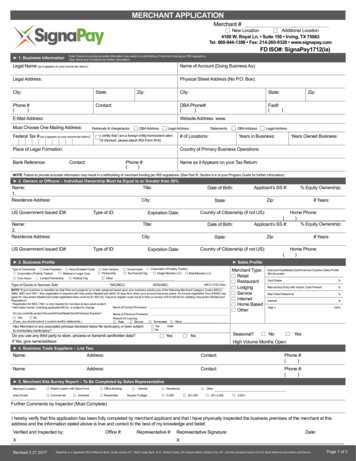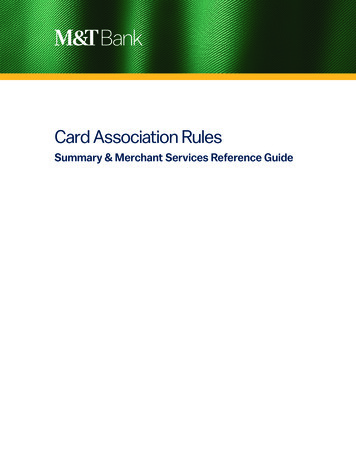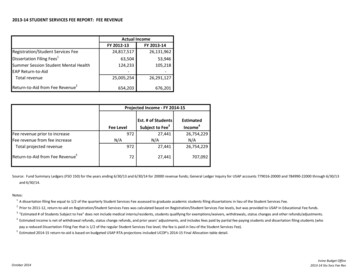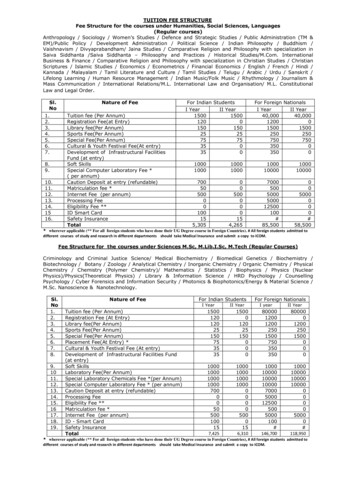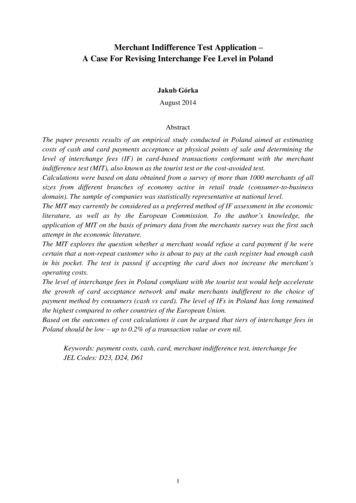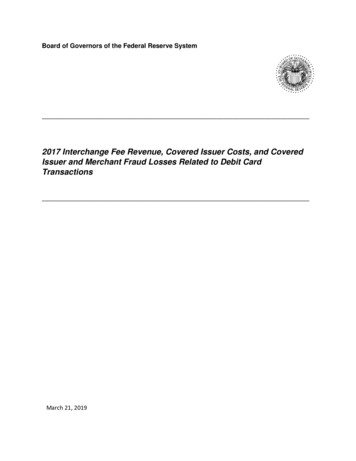
Transcription
Board of Governors of the Federal Reserve System2017 Interchange Fee Revenue, Covered Issuer Costs, and CoveredIssuer and Merchant Fraud Losses Related to Debit CardTransactionsMarch 21, 2019
HighlightsCard Use In 2017, payment card networks processed 68.5 billion debit and general-use prepaid cardtransactions valued at 2.62 trillion in the United States. Dual-message networks, which havetraditionally processed mainly signature-authenticated transactions, accounted for 64.9 and65.1 percent of the total by volume and value, respectively. Single-message networks, whichtypically process PIN-authenticated transactions, accounted for the rest.Total transaction volume grew 5.6 percent from 2016 to 2017, slower than the 7.0 percentgrowth recorded from 2015 to 2016.Compared with dual-message networks, single-message networks experienced fastertransaction volume growth. From 2016 to 2017, dual-message and single-message networksexperienced growth rates in volume of 4.7 and 7.2 percent, respectively. While dual-messagenetwork volume grew faster between 2009 and 2014, for the past three years, single-messagenetwork volume growth has surpassed that of dual-message networks.Card-not-present transactions accounted for 18.9 percent of transaction volume in 2017, butcard-not-present volume grew much faster from 2016 to 2017 than card-present volume, withthe card-not-present growth rate of 22.6 percent almost ten times the card-present growth rateof 2.3 percent. As in previous years, the average transaction value of card-not-presenttransactions, 62.98 in 2017, was nearly double that of card-present transactions ( 32.47 in2017).Issuers that are exempt from the interchange fee standard in Regulation II continued toexperience slightly slower transaction volume growth from 2016 to 2017 than covered issuers,with growth rates of 5.1 percent for exempt issuers and 5.9 percent for covered issuers.The growth in the volume of prepaid card transactions from 2016 to 2017 was 11.4 percent,faster than the average annual growth of 9.3 percent over the previous two years.Interchange Fees, Network Fees, and Incentives In 2017, interchange fees across all debit and general-use prepaid cards (exempt and covered)totaled 20.73 billion, an increase of 5.9 percent since 2016.The average interchange fee for covered transactions on both types of networks, in addition tothe average interchange fee for exempt transactions on dual-message networks, has notchanged materially since Regulation II took effect in the fourth quarter of 2011. These feesstood at 0.23 and 0.52, respectively, in 2017. By contrast, the average interchange fee forexempt transactions on single-message networks has been falling gradually since Regulation IItook effect, from 0.31 in the fourth quarter of 2011 to 0.25 in 2017.Network fees totaled 7.03 billion in 2017. Acquirers paid 63 percent of these fees; issuers paidthe rest. In recent years, the percentage paid by acquirers has increased slightly while thepercentage paid by issuers has correspondingly decreased.The average network fee per transaction was 0.103 in 2017, which has not changedsubstantially since 2011.Payments and incentives offered by networks grew 4.9 percent since 2016, totaling 1.61 billionin 2017. Issuers received 58 percent of payments and incentives in 2017; acquirers andmerchants received the rest.2
Fraud Across all debit and general-use prepaid card transactions for covered issuers, fraud losses to allparties as a share of the transaction value were 11.2 basis points, or 11.20 per 10,000 intransaction value, up from 10.3 basis points in 2015.In 2017, merchants absorbed 53 percent of losses from fraudulent transactions at coveredissuers, up from 39 percent in 2015, with issuers absorbing 42 percent, down from 58 percent in2015.Issuer Costs The average per-transaction authorization, clearing, and settlement (ACS) cost, excluding issuerfraud losses, across issuers covered by the interchange fee standard in Regulation II fell to 3.6cents in 2017. This is a cumulative decline of 54 percent since data collection began in 2009.The base interchange fee standard in Regulation II of 21 cents plus 5 basis points times the valueof a transaction exceeded the average per-transaction ACS cost, including issuer fraud losses, for76.0 percent of covered issuers and 99.7 percent of covered transactions in 2017. This is asubstantial increase in the percentage of covered issuers and a slight increase in the percentageof covered transactions compared with 2015.3
BackgroundThe Electronic Fund Transfer Act requires the Federal Reserve Board to biennially publish data on costsincurred, and interchange fees charged or received, by debit card issuers and payment card networks. 1The Board conducted its first data collection in 2010, collecting data from payment card networks andissuers for calendar year 2009. The information from the first data collection assisted the Board indeveloping Regulation II and was included in a report published in 2011. 2 Three subsequent reportssummarized data collected since the initial data collection. The most recent report, released in 2016,contained information through calendar year 2015. 3 The present report is the fifth in the series andcontains data through calendar year 2017.Regulation II establishes an interchange fee standard under which, for an electronic debit transaction,issuers with consolidated assets of 10 billion or more may not receive or charge an interchange feegreater than 21 cents plus 5 basis points times the value of that transaction. 4 An issuer that is subject tothe standard may be eligible to receive an additional 1 cent adjustment to the interchange fee it chargesor receives if the issuer meets certain fraud-prevention standards. Electronic debit transactions madeusing debit cards issued pursuant to government-administered payment programs and certainreloadable general-use prepaid cards are exempt from the interchange fee standard. 5The Board’s Data Collection ProcessThe Board conducts two surveys to collect information about the debit card industry, both of which aremandatory under Regulation II. The Payment Card Network (PCN) survey is conducted every year andsurveys payment card networks that process debit card transactions. The Debit Card Issuer (DCI) surveyis conducted every two years and surveys issuers that are subject to the interchange fee standard inRegulation II.The surveys ask respondents to report information on all debit card transactions that they process in agiven calendar year. Under Regulation II, debit cards are cards, or other payment codes or devices, thatare issued or approved for use through a payment card network to debit a transaction, savings, or otherasset account and that can be used at multiple unaffiliated merchants. 6 The surveys distinguish betweengeneral-use prepaid cards and other debit cards. General-use prepaid cards are debit cards that areissued on a prepaid basis for a specified amount, whether or not that amount may be increased orreloaded, in exchange for payment. 7 Although Regulation II defines prepaid cards to be a subset of debitcards, for ease of exposition, this report uses terminology that distinguishes between prepaid cards and15 U.S.C. 1693o-2(a)(3)(B) (2014).See 76 Fed. Reg. 43394 (Jul. 20, 2011).3 The reports, survey instruments, and historical data are available on the Board’s public website -collections.htm.4 One basis point is equal to one one-hundredth of one percent.5 A reloadable general-use prepaid card must meet certain conditions to be exempt from the interchange fee standard, such asnot being marketed or labeled as a gift card or gift certificate.6 The surveys exclude cards that can access only automated teller machine (ATM) networks and cannot be used as a form ofpayment.7 General-use prepaid cards contrast with private-label prepaid cards, which can be used only at an individual merchant or agroup of affiliated merchants. Because Regulation II does not cover cards, including prepaid cards, that can only be used at anindividual merchant or a group of affiliated merchants, the surveys do not collect information on such cards.124
other debit cards. In particular, the report uses the term “debit cards” to mean cards excluding prepaidcards. It further uses the term “prepaid cards” to mean general-use prepaid cards that are covered bythe definition of debit card in Regulation II.The surveys also distinguish between dual-message and single-message networks. A dual-messagenetwork typically uses separate messages to authorize and clear a transaction. Traditionally, thesenetworks have processed signature-authenticated transactions. Increasingly, however, sometransactions over these networks may not require signature authentication or may involve othermethods of cardholder authentication, such as entry of a personal identification number (PIN) orbiometric authentication. A single-message network typically uses a single message to authorize andclear a transaction. These networks normally process PIN-authenticated transactions, althoughincreasingly some transactions, such as small-value purchases, may not require PIN authentication. Thedistinction between single-message and dual-message networks continues to become less clear from afunctional perspective over time, as methods of cardholder authentication change and both types ofnetworks develop new functionalities. 8 This report continues to categorize networks as single-messageor dual-message because this categorization serves to distinguish networks into groupings that arewidely used by the industry.Payment Card Network SurveyThe Board conducted the most-recent PCN surveys in early 2017 and 2018, collecting data for calendaryears 2016 and 2017, respectively. All 13 card networks that processed debit card transactions in 2016and 2017 completed the survey for each of those years. 9 In addition to using data from these latest PCNsurveys for this report, the Board used the data to calculate the information it published in mid-2017and mid-2018 on the average interchange fees received by issuers across different networks. 10As in previous years, the PCN surveys for calendar years 2016 and 2017 asked respondents to reportinformation separately for issuers covered by the interchange fee standard (covered issuers) and issuersexempt from the interchange fee standard (exempt issuers). They further asked respondents todistinguish between prepaid card transactions that were covered by or exempt from the interchange feestandard. Since the collection of data for calendar year 2013, the PCN surveys have asked respondentsto distinguish exempt prepaid transactions initiated with cards issued by exempt issuers from thoseinitiated with cards issued by covered issuers. This distinction allows transactions reported in the PCNsurveys to be categorized as either exempt or covered. 11For example, in some instances, a dual-message network may use a single message to authorize and clear a given transaction.Similarly, in some instances, a network that typically uses single messages to authorize and clear transactions may use separatemessages to authorize and clear a given transaction.9 The survey instructed network companies that had both dual-message and single-message networks to provide separateresponses for each network. Similarly, if a network company processed both single-message and dual-message transactionsover a single network, the survey instructed the network company to provide separate responses for each type of transactionperformed over the network. Based on these reporting conventions, there were 18 total responses to the PCN survey forcalendar year 2017.10 Information on average interchange fees is available on the Board’s website age-interchange-fee.htm.11 In data collections before 2013, it was only possible to distinguish between covered and exempt issuers; that is, transactionsinitiated with cards issued by issuers who were covered by the interchange fee standard versus transactions initiated with cardsissued by issuers who were exempt from the standard. However, some transactions initiated with cards issued by issuers whoare covered by the standard may actually be exempt, if the card is an exempt prepaid card.85
As exhibit 1 illustrates, the difference between the transaction volume of covered issuers, whichincludes transactions initiated with exempt prepaid cards issued by covered issuers, and the volume ofcovered transactions, which excludes those transactions, was less than 3 percent of total transactionvolume in 2017, as has been the case in previous data collections. Depending on the context, this reportalternatively decomposes the data by transaction status under Regulation II (that is, exempt versuscovered transactions) or by issuer status (that is, exempt versus covered issuers).Exhibit 1: Composition of transaction volume in 2017100%Exempt transactions, debit cards,exempt issuers80%Exempt transactions, prepaid cards,exempt issuers20%Exempt transactions, prepaid cards,covered issuerscovered issuers40%covered transactions60%Covered transactions, prepaid cards,covered issuersCovered transactions, debit cards,covered issuers0%Debit Card Issuer SurveyThe Board conducted the latest DCI survey in 2018, asking covered issuers to report data for calendaryear 2017. As in previous data collections, respondents ranged from the largest debit card issuers in thecountry to issuers with sizable assets but very small debit card programs. 12 The DCI survey asked forinformation related to the volume and value of debit and prepaid card transactions; authorization,clearing, and settlement costs as well as other costs associated with a particular debit card transaction;the incidence of and losses related to debit and prepaid card fraud; fraud-prevention and data securitycosts; and interchange fee revenue. The DCI survey instructed respondents to provide the requested12 The Board distributed surveys to holding companies of covered financial institutions. These financial institutions includedbank and thrift holding companies with consolidated assets of at least 10 billion; independent commercial banks, thrifts, andcredit unions with assets of at least 10 billion; and U.S. branches and agencies of foreign banking organizations with worldwideassets of at least 10 billion. Assets were computed using the Consolidated Financial Statements for Bank Holding Companies(FR Y-9C; OMB No. 7100-0128), the Consolidated Reports of Condition and Income (Call Reports) for independent commercialbanks (FFIEC 031 & 041; OMB No. 7100-0036) and for U.S. branches and agencies of foreign banks (FFIEC 002; OMB No. 71000032), the Thrift Financial Reports (OTS 1313; OMB No. 1550-0023) for thrift holding companies and thrift institutions, and theCredit Union Reports of Condition and Income (NCUA 5300/5300S; OMB No. 3133-0004) for credit unions. The ownershipstructure of banking organizations was established using the Federal Financial Institutions Examination Council’s NationalInformation Center structure database. Participation was mandatory for institutions that had debit card programs in 2017.Institutions that indicated that they did not have a debit card program in 2017 were not required to complete a survey. Theseinstitutions were typically either foreign banking organizations or other financial institutions with large nonbank affiliates thatdo not provide retail banking services.6
information separately for debit card transactions processed over dual-message networks, debit cardtransactions processed over single-message networks, and prepaid card transactions for issuers withprepaid card programs. 13A total of 115 covered issuers responded to the 2017 DCI survey, compared with 129 respondents in2015. This change reflects a number of factors, including mergers and acquisitions involving covereddebit card issuers, the reported cessation of debit card activity by certain issuers with small debit cardprograms, and changes in covered issuers’ reporting practices. 14Exhibit 2: Composition of covered issuers and transaction volume/value of covered issuers in 2017100%80%60%40%20%0%% of issuers% of transactionsHigh-volumeMid-volume% of transaction valueLow-volumeExhibit 2 illustrates the composition of responses: 33 percent of the respondents processed more than100 million debit card transactions in 2017 (high-volume issuers), while 16 percent processed fewerthan 1 million debit card transactions in 2017 (low-volume issuers). The remaining 51 percent ofrespondents processed between 1 million and 100 million transactions in 2017 (mid-volume issuers).Compared with previous data collections, the respondents comprised a greater percentage of highvolume issuers and a lower percentage of low-volume issuers. In particular, relative to 2015, three moreissuers were classified as high-volume, reflecting general increases in transaction volumes that causedsome issuers to shift from the mid-volume category to the high-volume category. At the same time,compared with 2015, six fewer issuers were classified as mid-volume, and eleven fewer issuers wereclassified as low-volume, reflecting the previous low-volume respondents who reported that they nolonger had debit card programs in 2017. As in previous data collections, high-volume issuers accountedfor the vast majority of transaction volume and value. In 2017, high-volume issuers accounted for 96.21percent of transaction volume, mid-volume issuers accounted for 3.78 percent of transaction volume,and low-volume issuers accounted for 0.01 percent of transaction volume.Unlike the PCN survey, the DCI survey does not distinguish between general-use prepaid cards that were covered by theinterchange fee standard and those that were exempt.14 The Board allows affiliated depository institutions to submit separate or combined responses to the DCI survey. Whenaffiliated depository institutions file separate surveys, this report treats those surveys as distinct responses. As a result,combined reporting for depository institutions that previously reported separately alters the number of responses for thisreport.137
DiscussionCard UseThe PCN surveys have provided information about total card usage on a yearly basis since 2009. 15 Forthe past eight years, the volume of total card usage has grown steadily from 37.6 billion transactions in2009 to 68.5 billion transactions in 2017, with an average growth of 3.86 billion transactions per year(see exhibit 3). The total value of purchase transactions also exhibited growth, increasing from 1.43trillion in 2009 to 2.62 trillion in 2017, with average growth of 0.15 trillion per year. 16Exhibit 3: Volume and growth rate of purchase transactions over timeNOTE: The left vertical axis is associated with the bars representing the volume of transactions in each year. The right verticalaxis is associated with the line that represents the growth in volume of transactions since the previous year. The number oftransactions in 2010 is an interpolation from 2009 and 2011 values because survey data were not collected for 2010.A small fraction of purchase transactions resulted in chargebacks and returns. 17 In 2017, chargebackswere 0.03 percent of transactions, and returns about 0.80 percent of transactions. Together,Both the PCN survey and the DCI survey ask respondents for data pertaining to the number and value of settled purchasetransactions on debit cards. Settled purchase transactions include transactions that are later charged back or returned andexclude ATM transactions, funds loads to card accounts for prepaid cards, and any card activity in which value was nottransferred between a cardholder and a merchant, such as denials, errors, or authorizations that did not clear or were notpresented for settlement. A comparison of data from the two surveys suggests a high level of consistency across network andissuer responses. Because the DCI survey only includes covered issuers, the figures in this section come from PCN survey data.16 In a recent release, the Federal Reserve Payments Study reported higher total and growth rates in the number and value ofdebit card payments than reported here for 2017. The reported totals differ because that study covers a broader set ofpayments, including three-party network transactions not covered by Regulation II. That study also reports totals as “net,authorized and settled transactions,” which not only include net purchase transactions as defined in this report, but alsoinclude chargebacks, returns and adjustments, and cash back amounts. See “Federal Reserve Payments Study: 2018 AnnualSupplement,” available at ement-20181220.pdf.17 In a purchase transaction, value is transferred from the cardholder to the merchant in exchange for goods or services. In achargeback transaction, the issuer reverses a purchase transaction (because of, for example, customer disputes, fraud,158
chargebacks and returns totaled 0.57 billion transactions ( 0.03 trillion in value); purchase transactionsnet of chargebacks and returns totaled 67.9 billion transactions ( 2.59 trillion in value).Exhibit 4 examines growth rates in transactions by category from 2016 to 2017 (in red) compared withthose from 2009 to 2016 (in blue). The average annual growth rate in the volume of transactionsprocessed over dual-message networks has fallen considerably from 8.8 percent per year from 2009 to2016 to 4.7 percent from 2016 to 2017. At the same time, the average annual growth rate in the volumeof transactions processed over single-message networks has increased slightly from 6.8 percent per yearfrom 2009 to 2016 to 7.2 percent from 2016 to 2017.Exhibit 4: Average annual growth rate in transaction volume, by transaction category25%20%15%10%5%0%2009-20162016-2017NOTE: Exempt/covered issuer breakdown was first collected in 2011; the 2009-2016 growth rate for exempt/covered issuersthus corresponds to the growth rate from 2011 to 2016.As shown by the second set of bars in exhibit 4, growth in card-not-present transaction volumeaccelerated, increasing from an average annual growth rate of 16.6 percent per year from 2009 to 2016to 22.6 percent from 2016 to 2017. 18 In contrast, growth in card-present transaction volume, at 2.3percent from 2016 to 2017, was much lower. Moreover, growth in card-present transactions from 2016to 2017 fell sharply compared with the average annual growth rate of 6.9 percent per year from 2009 to2016.As shown by the third set of bars in exhibit 4, growth in transaction volume processed by exempt issuershas slowed, from an average annual growth rate of 8.1 percent from 2011 to 2016 to 5.1 percent from2016 to 2017. At the same time, the growth rate in volume processed by covered issuers decreasedfrom an average annual growth rate of 6.1 percent per year from 2011 to 2016 to 5.9 percent from 2016processing errors, authorization issues, or nonfulfillment of copy requests), in whole or in part, and value is transferred fromthe merchant to the cardholder. In a return transaction, the merchant reverses a purchase transaction (because of, forexample, the return of goods by the cardholder), in whole or in part, and value is transferred from the merchant to thecardholder.18 Card-not-present transactions include Internet, telephone, and mail-order transactions.9
to 2017. As shown by the final set of bars in exhibit 4, average annual growth in volume of prepaid cardtransactions has slowed from 18.2 percent per year from 2009 to 2016 to 11.4 percent from 2016 to2017. Average annual growth in volume of nonprepaid debit card transactions also slowed, from 7.7percent per year from 2009 to 2016 to 5.1 percent from 2016 to 2017.Exhibit 5 looks at the composition of transactions for the same categories and notes changes in thesecompositions in percentage points since data collection began. In 2017, transactions processed overdual-message networks accounted for 64.9 percent of debit card transaction volume, with transactionsprocessed over single-message networks accounting for the remaining 35.1 percent. The proportion oftransactions processed over dual-message networks has increased 2.5 percentage points since 2009.The share of card-not-present transactions out of total transaction volume has steadily increased sincesurveys began, reaching 18.9 percent in 2017, up 9.3 percentage points since 2009. The share oftransactions processed by exempt issuers has increased to 34.7 percent in 2017, up 1.9 percentagepoints since 2011. Finally, the share of transactions processed by prepaid cards rose to 6.3 percent in2017, up 3.1 percentage points since 2009.Exhibit 5: Composition of total transaction volume in 2017, by transaction category100%80%60%DM 2.5pp40%20%0%Prepaid 3.1ppExempt .5ppCard notpresent 9.3ppDual-message / Single- Card Present / Card-not- Exempt / Covered issuersmessagepresentPrepaid / DebitNOTE: Values reported alongside the columns are per-category changes relative to 2009, except in the case of exempt orcovered issuers, for which the change is relative to 2011; pp is percentage points. DM is dual-message; SM is single-message.10
As shown in exhibit 6, the average transaction value did not differ greatly in 2017 among transactioncategories, with one exception: card-not-present transactions, whose average value at 62.98 wasnearly double that for card-present transactions, with an average value of 32.47. Average transactionvalues also have not changed much from 2009 to 2017 for most transaction categories, again with theexception of card-not-present transactions. The average transaction value for this transaction type hasfallen by nearly 16 from 2009 to 2017, with half of the decline occurring in the last two years alone.Exhibit 6: Average transaction value, by transaction category 80 70 60 50 40 30 20 10 020092017NOTE: Exempt/covered issuer breakdown was not available in 2009; 2011 figures are reported instead.11
Interchange Fees, Network Fees, and IncentivesThe PCN survey requests information about interchange fees, certain network fees, and payments andincentives that are set, charged, or paid by payment card networks. 19 Transfers vary from network tonetwork; thus, the totals and averages reported in this section serve only as a general characterizationof network practices. Moreover, payments and incentives are usually bilateral arrangements between anetwork on one side and a merchant, acquirer, or issuer on the other. The figures reported in thissection, calculated from network-reported totals, do not reflect the heterogeneity of these bilateralarrangements.Exhibit 7 shows the main fees, as well as payments and incentives, exchanged among networks, issuers,and acquirers/merchants. The total value of interchange fees transferred from acquirers to issuers is byfar the largest: 20.73 billion in 2017. Network fees paid by issuers and acquirers in 2017 were 2.60billion and 4.43 billion, respectively. In each case, these network fees were considerably higher thanthe payments and incentives paid by the networks to issuers and acquirers/merchants: 0.93 billion and 0.68 billion, respectively.Exhibit 7: Fees and payments/incentives among networks, issuers, and acquirers in 2017NOTE: P&I is payments and incentives; bn is billions. The arrows represent the source and recipient of fees, payments, andincentives, rather than the actual path the money takes.Interchange fees are those fees set by the network, charged to acquirers, and received by issuers as part of a debit cardtransaction. The acquirer typically passes these fees on to the merchants so interchange fees can be thought of as a cost tomerchants and as revenue to debit card issuers. Network processing fees are total fees charged by payment card networks forservices that are required for the network processing of transactions and do not include any fees for optional services related totransaction processing that may be provided by a payment card network or an affiliate of a payment card network, or anynetwork fees that are not directly linked to the processing of transactions, such as membership or license fees.1912
Exhibit 8 illustrates the evolution of average interchange fees over time, depending on the card networktype and whether transactions were subject to the interchange fee standard. The average interchangefee per covered transaction in 2017 for transactions processed over dual-message networks, at around 0.22, was slightly less than the average interchange fee for covered transactions processed over singlemessage networks, at nearly 0.24. In both cases, the values were slightly less than the maximum thatan issuer could receive on an average covered transaction. 20 For transactions processed over dualmessage networks, the average interchange fee per exempt transaction was considerably higher thanthat for covered transactions ( 0.52 versus 0.22), whereas for transactions processed over singlemessage networks the average interchange fee per exempt transaction was only slightly higher thanthat for covered transactions ( 0.25 versus 0.24). Most of these values have not changed materiallysince Regulation II took effect. The only exception is a downward trend for the average interchange feefor exempt transactions processed over single-message networks; this value declined further to 0.25 in2017 after falling from 0.31 to 0.26 from 2011 to 2016.Exhibit 8: Average interchange fees over time, by network type and transaction statusNOTE: Values for each period are represented by a data point at the end of the period: end of year for 2011:Q4, 2012, 2013,2014, 2015, 2016, and 2017 data, and end
In 2017, interchange fees across all debit and general-use prepaid cards (exempt and covered) totaled 20.73 billion, an increase of 5.9 percent since 2016. The average interchange fee for covered transactions on both types of networks, in addition to the average interchange fee for exempt transactions on dual-message networks, has not
